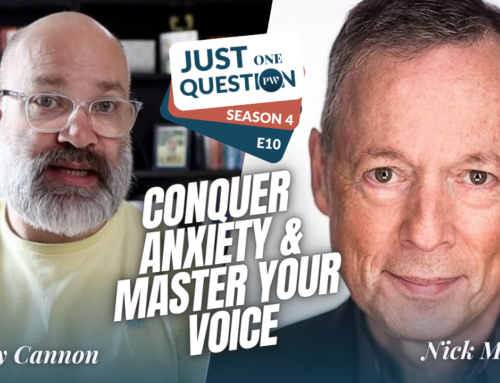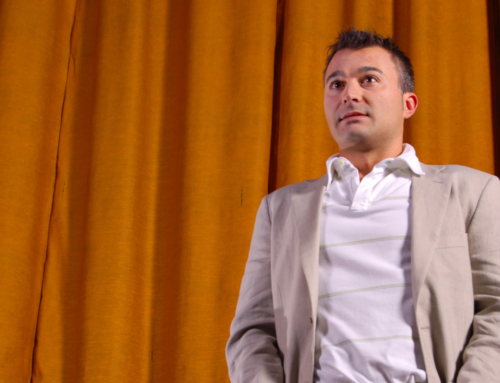I’ve recently been reminded that one of the universal constants in the public speaking world is fear. Most speakers have it, a few manage to avoid it, and some are crushed by it. A recent article about a survey of UK CEOs found that they, too, experience fear. Recent work with a client involved helping him with his fear of opening a speech. He’s fine once he gets going, but those first few minutes are debilitating. And I recently gave a speech after taking about a month off to work on a book proposal, and I found myself rusty and nervous just like everyone else.
What can you do about it? Here are 5 ideas to help you with that universal annoyance.
1. Redefine the fear as adrenaline, and therefore a good thing. This is my personal favorite, and it works pretty well if you stick to it over a long period of time. When we’re faced with having to speak in front of a crowd – or the prospect of one – the adrenaline starts flowing. It’s the well-known flight-or-fight syndrome that helps you get ready to do battle with ancient enemies. In addition to the annoying symptoms like dry mouth, or shaky knees, or clammy palms, your brain works faster, you have more energy, and you look a little larger than life. And that’s all good. So focus on the good things that those symptoms are bringing you, and you’ll start to think differently about those clammy palms.
2. Rehearse, rehearse, rehearse. Rehearse a lot. Rehearsal is the best way to deal with nerves, objectively speaking, because what you do a lot you get comfortable with and thus are less likely to get frightened about. Rehearsal has the added benefit of most likely making you better at the presentation – certainly better than if you wing it. And you’ll look more polished because your body will signal to the audience, “I’ve done this before; I’m cool.”
3. Breathe deeply, from the belly. Breathe slowly, and often. Breathing is good for you, your voice, and your composure. A slow, deep belly breath supported from the diaphragmatic muscles will start an autonomic relaxation response that nicely counteracts those feelings of terror, so start at the first sign of symptoms. Because those belly breaths will ground you, make sure you do them just before you get up to speak – while you’re being introduced, for example.
4. Focus on the audience, not on yourself. The real insight at the core of successful public speaking is that it isn’t about you, it’s about the audience getting it (or you were never there, in some sense). So focus on the audience, let go of yourself, and have a great time. I think of this as the Zen insight into public speaking, and it is truly liberating if you can convince yourself of it.
5. Focus on an emotion that you want to convey to the audience. If you’re the sort of speaker who starts riffing on all the things that might go wrong when you get nervous about speaking, then you’re like most of us. The idea is to replace that doom loop with something more productive. For a host of reasons, replacing nervous mental chatter with a strong emotion is a great substitute. Here’s how you do it. First, figure out what emotion is appropriate to the beginning of your speech. It might be anger, joy, excitement, whatever. Then, recall a time when you felt that emotion naturally and strongly. But don’t just remember it – relive it. Recall what it smelled, tasted, looked, sounded and felt like. Shut your eyes and put yourself there. With practice, this can become a powerful and quick way to focus before speaking. And if you do this sense memory thoroughly enough, you’ll chase the nervous thoughts out of your head.
We all get nervous, but there are ways to minimize nerves, and to use the mental state to your advantage, to make you a better speaker. Try them all, and pick the one or ones that works best for you.








Strongly agree with you about re-defining the fear as adrenalin. The fear can be there to help us, and like a black-run skier it stimulates us to perform, so long as we can, as you advise, master the beast and be at our best.
Thanks, Peter, for the comment. I like the image of a black-run skier — as a fan of skiing myself, the metaphor works! It’s all about getting that surge of adrenaline to get you to peak performance.
These are very helpful pointers. As a public speaking trainer I’d like to add one more which is also about really connecting with your audience.
It taps into the research done into the Social Nervous System by Dr Stephen Porges.
Dr Porges’ research found that it is deeply soothing for human beings to feel connected to each other. Simply by allowing your eyes to gently meet the eyes of the people you’re speaking to (and here’s one of the keys – for long enough for you to feel a real connection) your SNS will be switched on and the body’s self-soothing response will be activated. This is particularly helpful when speaking in public. Not only will you feel relaxed and connected to your audience, they will also feel connected to you.
Lee Glickstein has developed this into a method that he calls Speaking Circles – see his book Be Heard Now (available cheaply on Amazon).
If anyone is interested in taking this method further I offer training in London ( http://www.stepfowardandspeak.co.uk ) and there are other facilitators in various other parts of the world – see http://www.speakingcircles.com
Hi, Daniel —
Thanks for the great comment. I saw the Dalai Lama do exactly that once, and it was powerful. Of course, he didn’t seem very nervous to begin with — more serene:-)
[…] second-best response is to practice some relaxation techniques to take the edge off the unpleasant feelings and then go ahead and use the adrenaline to perform at […]
[…] RADA Richard was taught to breathe, deeply and from the belly. As I’ve blogged about many times, good breathing is the beginning of all good speaking and performance, whether you’re […]